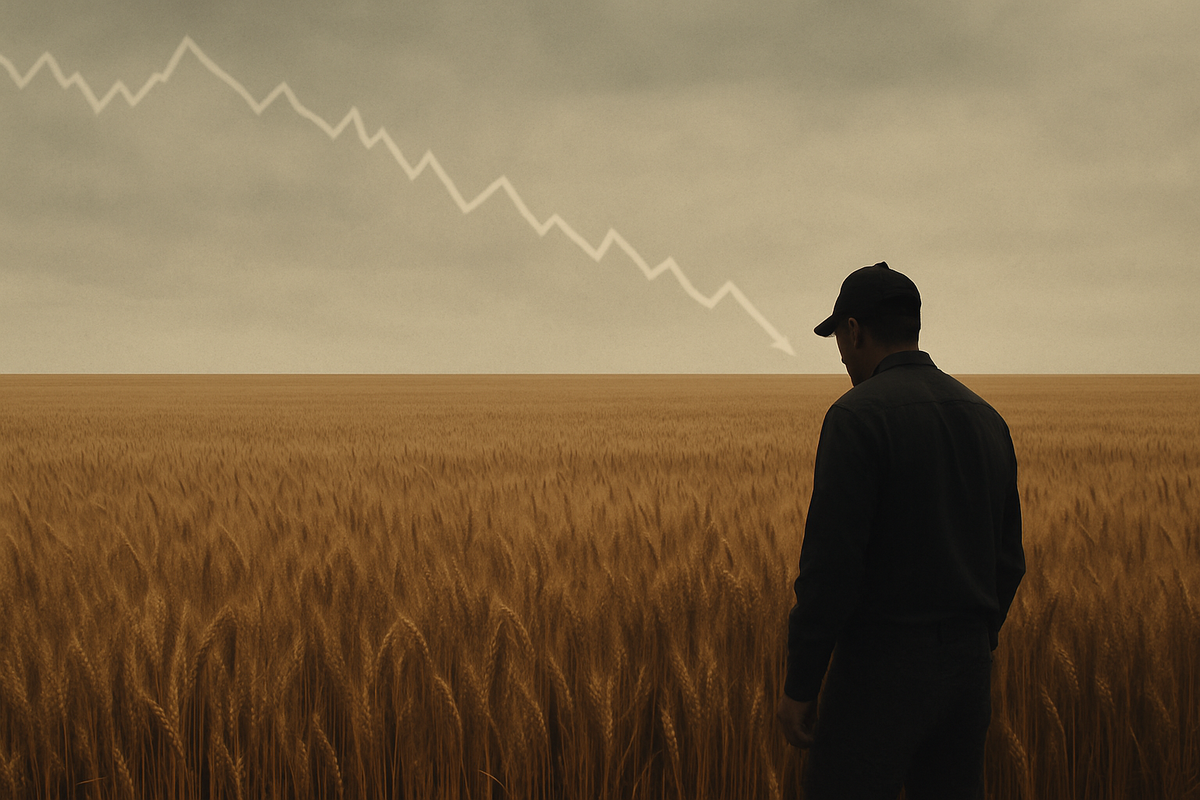
Kansas City, MO (October 14, 2025) – The hard red winter (HRW) wheat market is grappling with significant headwinds as futures contracts dipped to new contract lows this week, signaling a challenging environment for prices and the broader agricultural commodities sector. While basis bids for HRW wheat have remained largely unchanged, the persistent decline in futures points to a global oversupply that is putting considerable financial strain on producers.
The immediate implications are clear: continued downward pressure on wheat prices, escalating financial difficulties for farmers facing rising production costs, and a generally subdued outlook for most agricultural commodities. This market movement, reported by Reuters via TradingView, underscores a complex interplay of global supply dynamics and localized demand, creating an uncertain landscape for market participants.
Detailed Market Dynamics and Contributing Factors
The recent downturn in hard red winter wheat futures has been stark. Specifically, the Kansas City (K.C.) December contract (KWZ25) settled at $4.81-1/4 per bushel on October 13, 2025, after touching a contract low of $4.79-1/2. This bearish trend continued into early trading on October 14, with futures once again hitting fresh contract lows before a midday rally saw prices close higher at $4.88-1/2 a bushel due to some bargain buying and short covering. Despite this minor rebound, the overarching market sentiment remains decidedly bearish, with wheat prices having plummeted 51% from their pandemic peaks and reaching a five-year low.
This persistent decline is primarily driven by an abundance of global grain supplies. Key contributors include robust harvests and increased export competition, particularly from Russia. Consultants SovEcon, for instance, recently raised their forecast for Russia's 2025 wheat crop to a staggering 87.8 million metric tons, citing record yields in Siberia. Expectations of large upcoming harvests in Argentina and Australia are further exacerbating the global oversupply situation.
In contrast to the volatile futures market, basis bids for hard red winter wheat have shown remarkable stability at elevators across the southern U.S. Plains around October 13-14, 2025. While overall basis bids held steady, protein premiums for specific grades of HRW wheat did firm up, reflecting targeted demand from domestic flour millers. This localized demand for particular wheat qualities, coupled with farmers' reluctance to sell at current low futures prices, provides a nuanced picture within the broader bearish trend. Farmers are also heavily occupied with the autumn harvest of corn, soybeans, and sorghum, as well as planting the 2026 winter wheat crop, which further limits their selling activity and contributes to the stability of cash prices in some areas.
Public Companies Navigating the Wheat Market Downturn
The persistent dip in hard red winter wheat futures creates a clear divide between potential winners and losers in the agricultural sector. Companies involved in commodity trading, food processing, and agricultural inputs will feel the ripple effects.
On the losing side, farmers are undoubtedly the most impacted. The combination of persistently low commodity prices for wheat, corn, and soybeans, coupled with steadily increasing production costs for labor, fertilizer, and fuel, is creating immense financial stress. Many producers are struggling to break even, leading to per-acre losses and a concerning rise in farm losses and bankruptcy filings. This pressure on farmers can also indirectly affect agricultural equipment manufacturers like Deere & Company (NYSE: DE) and seed and chemical suppliers such as Corteva Agriscience (NYSE: CTVA) or Bayer AG (ETR: BAYN), as farmers reduce capital expenditures and input purchases in response to tighter margins.
Conversely, some players may find themselves in a more advantageous position. Large-scale commodity traders and food processors could be winners from lower raw material costs. Companies like Archer-Daniels-Midland Company (NYSE: ADM) and Bunge Global SA (NYSE: BG), major players in grain origination, processing, and merchandising, could benefit from cheaper wheat inputs, potentially boosting their processing margins. While Cargill is a private company, its similar business model would also likely see benefits. Flour millers and food manufacturers, such as General Mills, Inc. (NYSE: GIS) or Conagra Brands, Inc. (NYSE: CAG), which use wheat as a primary ingredient for products like bread, pasta, and cereals, could also see their input costs decrease. This could translate into improved profitability or allow them to offer more competitive pricing to consumers, though intense competition in the food sector often limits the extent to which these savings are passed on.
The stability in basis bids, alongside firming protein premiums, also suggests that companies with specific demand for high-quality HRW wheat for milling purposes might be insulated from the worst of the futures market downturn, potentially even securing their specific needs at relatively favorable cash prices compared to historical highs.
Wider Significance and Historical Context
The current state of the hard red winter wheat market is not an isolated event but rather a symptom of broader trends within global agricultural commodities. The most significant trend is the sustained period of abundant global grain supplies, driven by technological advancements, favorable weather in key growing regions, and increased production efficiencies in major exporting nations like Russia, the U.S., and Australia. This oversupply creates a buyer's market, making it difficult for prices to sustain any significant upward momentum.
The ripple effects of persistently low wheat prices extend beyond farmers and processors. Competitors in other grain markets, such as corn and soybeans, are also experiencing downward pressure. While specific factors like U.S.-China trade tensions impact soybeans and advancing harvests affect corn, the overall sentiment of oversupply in staple crops is pervasive. This creates a challenging environment for integrated agricultural businesses that deal in multiple commodities. The livestock sector, however, appears to be an exception, with cattle and meat prices seeing increases due to tight supplies, indicating a divergence in commodity performance.
Regulatory and policy implications are also noteworthy. The financial stress on farmers often leads to calls for government intervention, such as increased subsidies, disaster relief, or adjustments to agricultural trade policies. An ongoing U.S. government shutdown, which has deprived market participants of crucial USDA data, including crop progress reports, further complicates the situation. This lack of transparency adds to market caution and makes informed decision-making more challenging for traders and policymakers alike. Historically, periods of sustained low commodity prices have often led to significant shifts in agricultural policy, aiming to stabilize farmer incomes and ensure food security. The 1980s farm crisis, for example, saw widespread bankruptcies and subsequently led to significant policy reforms. While the current situation is not yet at that extreme, the trajectory is concerning.
What Comes Next: Navigating an Oversupplied Market
Looking ahead, the hard red winter wheat market faces both short-term volatility and long-term structural challenges. In the short term, price movements will likely be influenced by technical trading, bargain hunting, and any sudden shifts in weather patterns in key growing regions. Small rallies, like the one observed on October 14, could occur, but significant, sustained price appreciation appears unlikely without a major supply disruption or a substantial increase in global demand. Farmers will continue to be reluctant sellers at current price levels, potentially leading to tight cash supplies in some localized areas, which could support basis bids.
In the long term, the outlook remains largely dependent on global supply-demand fundamentals. Unless there's a significant reduction in global production (due to widespread adverse weather, disease, or policy changes) or a surge in demand (perhaps from unexpected geopolitical events or rapid population growth in food-deficit regions), the market is likely to remain in an oversupplied state. This necessitates strategic pivots for various stakeholders. Farmers may need to explore alternative crops, adopt more efficient farming practices to lower per-unit costs, or seek out niche markets for specialty wheat varieties that command higher premiums.
For agricultural companies, market opportunities may emerge in areas of logistics, storage, and risk management. With abundant supply, efficient transportation and storage become even more critical. Companies adept at navigating volatile markets through hedging strategies and diversified portfolios will be better positioned. Challenges include maintaining profitability in a low-price environment and managing potential supply chain disruptions. Potential scenarios range from a continued "lower for longer" price environment, forcing consolidation and innovation within the agricultural sector, to a sudden geopolitical event or climate shock that could temporarily rebalance the market, leading to sharp, albeit potentially short-lived, price increases.
Comprehensive Wrap-Up and Investor Outlook
The current dip of hard red winter wheat futures to new contract lows is a critical event, underscoring the profound impact of global oversupply on agricultural commodity markets. The key takeaways are clear: farmers are under immense financial pressure, major grain handlers and food processors may see benefits from lower input costs, and the broader agricultural sector is navigating a period of significant uncertainty exacerbated by a lack of crucial government data.
Moving forward, the wheat market is expected to remain highly sensitive to global production forecasts, export competition, and macroeconomic factors. While localized demand for specific wheat qualities provides some resilience in basis bids, the overarching trend points to a challenging environment for producers. The current situation highlights the inherent volatility and cyclical nature of agricultural markets, where periods of abundance can quickly erode profitability.
Investors should closely watch several factors in the coming months. These include updates on global harvest progress, particularly from Russia, Australia, and Argentina; any shifts in U.S. agricultural policy or trade agreements; and the resolution of the U.S. government shutdown, which would restore vital market data. Additionally, monitoring the financial health of agricultural input companies and farm lenders can provide further insights into the extent of stress within the farming community. For those invested in food processing and commodity trading, the ability of these companies to leverage lower raw material costs while managing market risks will be paramount.
This content is intended for informational purposes only and is not financial advice





